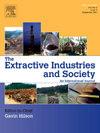Sustainable pathways for rural sand mining: Integrating socioeconomic resilience, financial viability and environmental stewardship in Badulu Oya, Sri Lanka
IF 4.3
2区 社会学
Q2 ENVIRONMENTAL STUDIES
Extractive Industries and Society-An International Journal
Pub Date : 2025-07-30
DOI:10.1016/j.exis.2025.101744
引用次数: 0
Abstract
Sand mining is a prominent livelihood strategy in rural Sri Lanka, particularly in the Badulu Oya region. While it provides essential income for local communities, unregulated practices have resulted in significant environmental degradation and institutional challenges. This study explores the socioeconomic, financial, and environmental dimensions of sand mining through a qualitative approach, supported by GIS-based land use/land cover (LULC) analysis between 2016 and 2024. Findings reveal that sand mining remains a profitable but precarious livelihood, constrained by seasonal variability, licensing delays, and limited alternative employment. Workers face exposure to health risks due to polluted water, while gendered labor roles and bureaucratic inefficiencies undermine equitable participation. Financially, the sector offers high returns relative to rural alternatives, yet profitability is offset by rising costs and regulatory limitations. Environmentally, the activity has accelerated riverbank erosion, biodiversity loss, and land degradation. Governance remains fragmented, with gaps in enforcement, public engagement, and data-driven resource management. This study proposes a six-point framework for sustainable rural sand mining, grounded in both stakeholder insights and GIS-based environmental change analysis. Furthermore, the study reframes sand mining as a rural governance issue, linking informal labor, environmental vulnerability, and institutional fragmentation. These contributions provide methodological and conceptual insights applicable to other Global South regions. These findings underscore the need for integrated rural governance that aligns environmental stewardship with socioeconomic resilience.
农村采砂的可持续途径:在斯里兰卡Badulu Oya整合社会经济弹性、财务可行性和环境管理
采砂是斯里兰卡农村的一项重要生计战略,特别是在Badulu Oya地区。虽然它为当地社区提供了基本收入,但不受管制的做法造成了严重的环境退化和体制挑战。本研究以2016年至2024年基于gis的土地利用/土地覆盖(LULC)分析为支撑,通过定性方法探讨了采砂的社会经济、金融和环境维度。调查结果显示,采砂仍然是一种有利可图但不稳定的生计,受到季节变化、许可延迟和有限的替代就业的限制。由于水污染,工人面临健康风险,而性别劳动角色和官僚效率低下破坏了公平参与。从财务上讲,该行业的回报高于农村,但盈利能力被成本上升和监管限制所抵消。在环境方面,这种活动加速了河岸侵蚀、生物多样性丧失和土地退化。治理仍然支离破碎,在执法、公众参与和数据驱动的资源管理方面存在差距。本研究基于利益相关者的见解和基于gis的环境变化分析,提出了可持续农村采砂的六点框架。此外,该研究将采砂作为一个农村治理问题,将非正式劳动力、环境脆弱性和制度碎片化联系起来。这些贡献提供了适用于全球南方其他地区的方法和概念见解。这些发现强调了综合农村治理的必要性,使环境管理与社会经济韧性保持一致。
本文章由计算机程序翻译,如有差异,请以英文原文为准。
求助全文
约1分钟内获得全文
求助全文
来源期刊

Extractive Industries and Society-An International Journal
ENVIRONMENTAL STUDIES-
CiteScore
6.60
自引率
19.40%
发文量
135
 求助内容:
求助内容: 应助结果提醒方式:
应助结果提醒方式:


